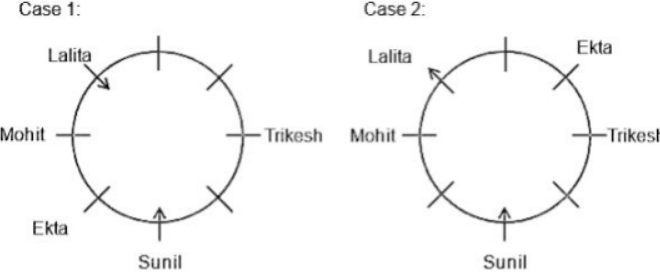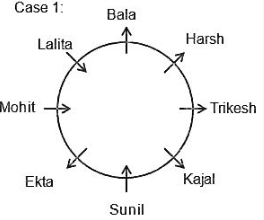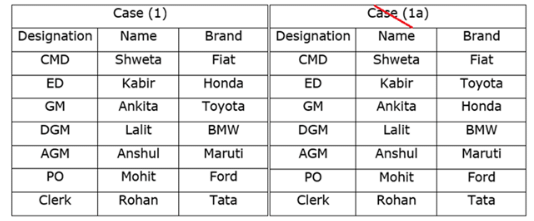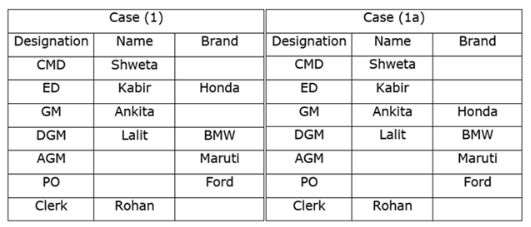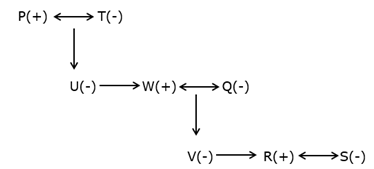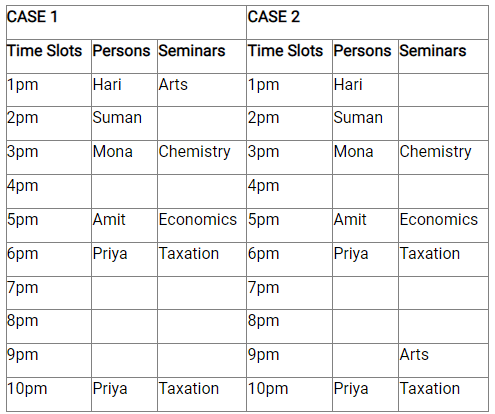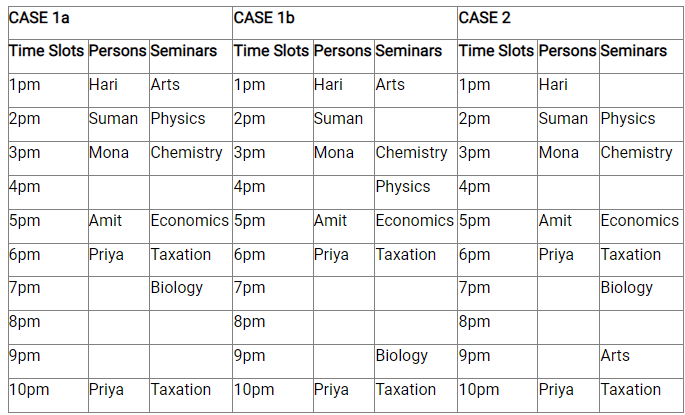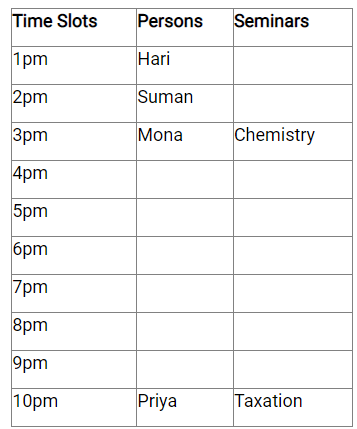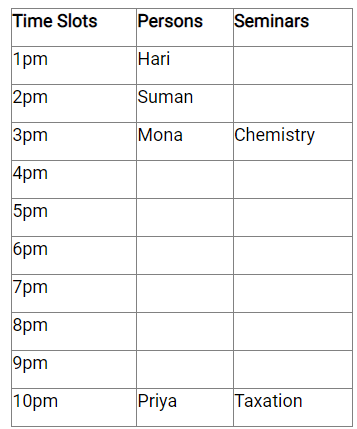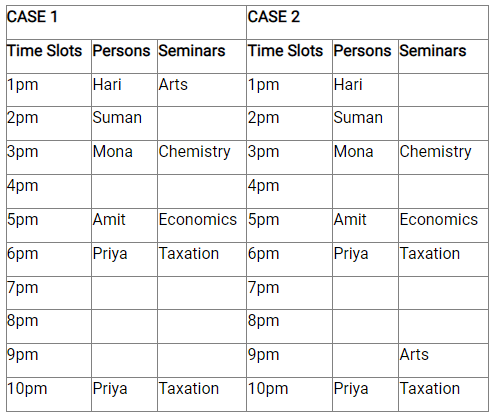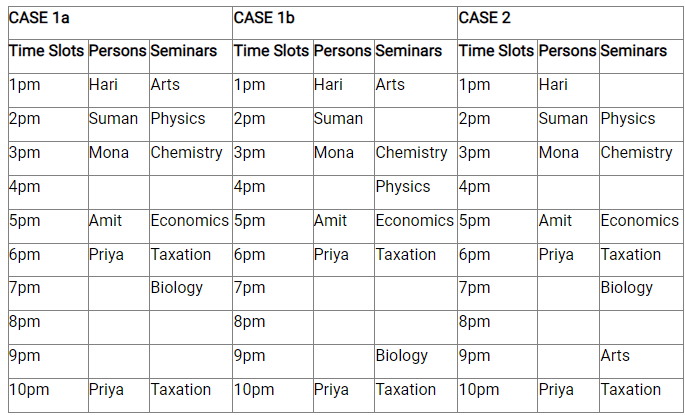IBPS PO Mains Mock Test - 7 - Bank Exams MCQ
30 Questions MCQ Test - IBPS PO Mains Mock Test - 7
Direction: Read the following information and answer the questions asked below.
Eight persons Mohit, Lalita, Harsh, Trikesh, Bala, Ekta, Kajaland Sunil are sitting around a circular table but not necessarily in the same order. Some of them are facing the centre while others are facing away from the centre.
Lalita is sitting third to the left of Sunil, who is facing towards the centre. Ekta is sitting second to the right of Lalita. Mohit and Trikesh sit opposite to each other. Trikesh is not an immediate neighbour of Lalita. Bala sits second to the left of Mohit. Kajal sits second to the left of Ekta. Immediate left neighbour of Lalita are facing the opposite direction. Trikesh faces away from the centre. Harsh sits immediate to the left of Trikesh. Kajal and Harsh are facing the same direction as that of Ekta.
Who among the following are immediate neighbours of Trikesh?
Direction: Read the following information and answer the questions asked below.
Eight persons Mohit, Lalita, Harsh, Trikesh, Bala, Ekta, Kajaland Sunil are sitting around a circular table but not necessarily in the same order. Some of them are facing the centre while others are facing away from the centre.
Lalita is sitting third to the left of Sunil, who is facing towards the centre. Ekta is sitting second to the right of Lalita. Mohit and Trikesh sit opposite to each other. Trikesh is not an immediate neighbour of Lalita. Bala sits second to the left of Mohit. Kajal sits second to the left of Ekta. Immediate left neighbour of Lalita are facing the opposite direction. Trikesh faces away from the centre. Harsh sits immediate to the left of Trikesh. Kajal and Harsh are facing the same direction as that of Ekta.
Which of the following is true about Bala?
Direction: Read the following information and answer the questions asked below.
Eight persons Mohit, Lalita, Harsh, Trikesh, Bala, Ekta, Kajaland Sunil are sitting around a circular table but not necessarily in the same order. Some of them are facing the centre while others are facing away from the centre.
Lalita is sitting third to the left of Sunil, who is facing towards the centre. Ekta is sitting second to the right of Lalita. Mohit and Trikesh sit opposite to each other. Trikesh is not an immediate neighbour of Lalita. Bala sits second to the left of Mohit. Kajal sits second to the left of Ekta. Immediate left neighbour of Lalita are facing the opposite direction. Trikesh faces away from the centre. Harsh sits immediate to the left of Trikesh. Kajal and Harsh are facing the same direction as that of Ekta.
What is the position of Ekta with respect to Sunil?
Direction: Read the following information and answer the questions asked below.
Eight persons Mohit, Lalita, Harsh, Trikesh, Bala, Ekta, Kajaland Sunil are sitting around a circular table but not necessarily in the same order. Some of them are facing the centre while others are facing away from the centre.
Lalita is sitting third to the left of Sunil, who is facing towards the centre. Ekta is sitting second to the right of Lalita. Mohit and Trikesh sit opposite to each other. Trikesh is not an immediate neighbour of Lalita. Bala sits second to the left of Mohit. Kajal sits second to the left of Ekta. Immediate left neighbour of Lalita are facing the opposite direction. Trikesh faces away from the centre. Harsh sits immediate to the left of Trikesh. Kajal and Harsh are facing the same direction as that of Ekta.
How many persons sit between Kajal and Mohit when counted anticlockwise from Mohit?
Direction: Read the following information and answer the questions asked below.
Eight persons Mohit, Lalita, Harsh, Trikesh, Bala, Ekta, Kajaland Sunil are sitting around a circular table but not necessarily in the same order. Some of them are facing the centre while others are facing away from the centre.
Lalita is sitting third to the left of Sunil, who is facing towards the centre. Ekta is sitting second to the right of Lalita. Mohit and Trikesh sit opposite to each other. Trikesh is not an immediate neighbour of Lalita. Bala sits second to the left of Mohit. Kajal sits second to the left of Ekta. Immediate left neighbour of Lalita are facing the opposite direction. Trikesh faces away from the centre. Harsh sits immediate to the left of Trikesh. Kajal and Harsh are facing the same direction as that of Ekta.
Four are the same in a certain way out of five. Which of the following is different from others?
Study the following information carefully and answer the following question.
Seven persons –Lalit, Ankita, Shweta, Mohit, Kabir, Rohan, and Anshul are working in a bank at different designations viz.- Chairman and Managing Director(CMD), Executive Director(ED), General Manager(GM), Deputy General Manager(DGM), Assistant General Manager(AGM), PO and Clerk. The designations are in descending order such as Chairman and Managing Director(CMD) is the seniormost designated person whereas Clerk is the juniormost designated person. Each person likes different car brands viz.- Maruti, Ford, BMW, Fiat, TATA, Toyota, and Honda. All the information is not necessary in the same order.
Note: Any employee can be promoted by his higher designated person but not immediately higher designated person.
Rohan neither likes Toyota nor Ford. The one who likes BMW is three persons senior to Rohan. Kabir promotes the one who likes BMW but doesn’t like Toyota. Three persons are designated between Shweta and the one who likes Maruti. Not more than one person is designated between the one who likes Honda and Lalit. The number of persons designated between the one who likes Maruti and Rohan is one less than the number of persons senior to Ankita. Lalit is two persons senior to the one who likes Ford. Mohit gets promoted by the one who likes Fiat and is immediately senior to the one who likes Tata. Neither Kabir nor Ankita likes Fiat.
Who among the following person likes Toyota?
Study the following information carefully and answer the following question.
Seven persons –Lalit, Ankita, Shweta, Mohit, Kabir, Rohan, and Anshul are working in a bank at different designations viz.- Chairman and Managing Director(CMD), Executive Director(ED), General Manager(GM), Deputy General Manager(DGM), Assistant General Manager(AGM), PO and Clerk. The designations are in descending order such as Chairman and Managing Director(CMD) is the seniormost designated person whereas Clerk is the juniormost designated person. Each person likes different car brands viz.- Maruti, Ford, BMW, Fiat, TATA, Toyota, and Honda. All the information is not necessary in the same order.
Note: Any employee can be promoted by his higher designated person but not immediately higher designated person.
Rohan neither likes Toyota nor Ford. The one who likes BMW is three persons senior to Rohan. Kabir promotes the one who likes BMW but doesn’t like Toyota. Three persons are designated between Shweta and the one who likes Maruti. Not more than one person is designated between the one who likes Honda and Lalit. The number of persons designated between the one who likes Maruti and Rohan is one less than the number of persons senior to Ankita. Lalit is two persons senior to the one who likes Ford. Mohit gets promoted by the one who likes Fiat and is immediately senior to the one who likes Tata. Neither Kabir nor Ankita likes Fiat.
Who among the following person designated as DGM?
Study the following information carefully and answer the following question.
Seven persons –Lalit, Ankita, Shweta, Mohit, Kabir, Rohan, and Anshul are working in a bank at different designations viz.- Chairman and Managing Director(CMD), Executive Director(ED), General Manager(GM), Deputy General Manager(DGM), Assistant General Manager(AGM), PO and Clerk. The designations are in descending order such as Chairman and Managing Director(CMD) is the seniormost designated person whereas Clerk is the juniormost designated person. Each person likes different car brands viz.- Maruti, Ford, BMW, Fiat, TATA, Toyota, and Honda. All the information is not necessary in the same order.
Note: Any employee can be promoted by his higher designated person but not immediately higher designated person.
Rohan neither likes Toyota nor Ford. The one who likes BMW is three persons senior to Rohan. Kabir promotes the one who likes BMW but doesn’t like Toyota. Three persons are designated between Shweta and the one who likes Maruti. Not more than one person is designated between the one who likes Honda and Lalit. The number of persons designated between the one who likes Maruti and Rohan is one less than the number of persons senior to Ankita. Lalit is two persons senior to the one who likes Ford. Mohit gets promoted by the one who likes Fiat and is immediately senior to the one who likes Tata. Neither Kabir nor Ankita likes Fiat.
How many persons are senior to the one who likes Honda?
Study the following information carefully and answer the following question.
Seven persons –Lalit, Ankita, Shweta, Mohit, Kabir, Rohan, and Anshul are working in a bank at different designations viz.- Chairman and Managing Director(CMD), Executive Director(ED), General Manager(GM), Deputy General Manager(DGM), Assistant General Manager(AGM), PO and Clerk. The designations are in descending order such as Chairman and Managing Director(CMD) is the seniormost designated person whereas Clerk is the juniormost designated person. Each person likes different car brands viz.- Maruti, Ford, BMW, Fiat, TATA, Toyota, and Honda. All the information is not necessary in the same order.
Note: Any employee can be promoted by his higher designated person but not immediately higher designated person.
Rohan neither likes Toyota nor Ford. The one who likes BMW is three persons senior to Rohan. Kabir promotes the one who likes BMW but doesn’t like Toyota. Three persons are designated between Shweta and the one who likes Maruti. Not more than one person is designated between the one who likes Honda and Lalit. The number of persons designated between the one who likes Maruti and Rohan is one less than the number of persons senior to Ankita. Lalit is two persons senior to the one who likes Ford. Mohit gets promoted by the one who likes Fiat and is immediately senior to the one who likes Tata. Neither Kabir nor Ankita likes Fiat.
Which of the following statement is true?
Directions: Study the following information carefully and answer the given questions.
When a word and number arrangement machine is given an input line of words and numbers, it arranges them following a particular rule. The following is an illustration of input and rearrangement:
(All the numbers are two-digit numbers).
Input: hidden 39 protect jingle 93 26 fog 69 moon 54 dance 75
Step I: 40 hidden 39 protect jingle 26 fog 69 moon 54 75 dance
Step II: 58 40 hidden 39 protect jingle 26 69 moon 54 dance fog
Step III: 97 58 40 39 protect jingle 26 moon 54 dance fog hidden
Step IV: 46 97 58 40 39 protect 26 moon dance fog hidden jingle
Step V: 94 46 97 58 40 protect 26 dance fog hidden jingle moon
Step VI: 63 94 46 97 58 40 dance fog hidden jingle moon protect
Step VI is the last step of the above arrangement dance the intended arrangement is obtained.
As per the rules followed in the given steps, find out the appropriate steps for the given input.
Input: hold 71 open 59 equal 81 13 shift count 68 kitten 46
If in step III, ‘19’ interchanges its position with ‘kitten’ and ‘59’ also interchanges its position with ‘equal’ then which of the elements will be to the immediate left of ‘46’?
Directions: Study the following information carefully and answer the given questions.
When a word and number arrangement machine is given an input line of words and numbers, it arranges them following a particular rule. The following is an illustration of input and rearrangement:
(All the numbers are two-digit numbers).
Input: hidden 39 protect jingle 93 26 fog 69 moon 54 dance 75
Step I: 40 hidden 39 protect jingle 26 fog 69 moon 54 75 dance
Step II: 58 40 hidden 39 protect jingle 26 69 moon 54 dance fog
Step III: 97 58 40 39 protect jingle 26 moon 54 dance fog hidden
Step IV: 46 97 58 40 39 protect 26 moon dance fog hidden jingle
Step V: 94 46 97 58 40 protect 26 dance fog hidden jingle moon
Step VI: 63 94 46 97 58 40 dance fog hidden jingle moon protect
Step VI is the last step of the above arrangement dance the intended arrangement is obtained.
As per the rules followed in the given steps, find out the appropriate steps for the given input.
Input: hold 71 open 59 equal 81 13 shift count 68 kitten 46
Which element comes exactly between ‘59’ and ‘shift’ in step II of the given input?
Directions: Study the following information carefully and answer the given questions.
When a word and number arrangement machine is given an input line of words and numbers, it arranges them following a particular rule. The following is an illustration of input and rearrangement:
(All the numbers are two-digit numbers).
Input: hidden 39 protect jingle 93 26 fog 69 moon 54 dance 75
Step I: 40 hidden 39 protect jingle 26 fog 69 moon 54 75 dance
Step II: 58 40 hidden 39 protect jingle 26 69 moon 54 dance fog
Step III: 97 58 40 39 protect jingle 26 moon 54 dance fog hidden
Step IV: 46 97 58 40 39 protect 26 moon dance fog hidden jingle
Step V: 94 46 97 58 40 protect 26 dance fog hidden jingle moon
Step VI: 63 94 46 97 58 40 dance fog hidden jingle moon protect
Step VI is the last step of the above arrangement dance the intended arrangement is obtained.
As per the rules followed in the given steps, find out the appropriate steps for the given input.
Input: hold 71 open 59 equal 81 13 shift count 68 kitten 46
If in the last step, ‘1’ is added to each of the odd numbers and ‘2’ is subtracted from each of the even numbers, then how many numbers multiple of ‘4’ will be formed?
Directions: Study the following information carefully and answer the given questions.
When a word and number arrangement machine is given an input line of words and numbers, it arranges them following a particular rule. The following is an illustration of input and rearrangement:
(All the numbers are two-digit numbers).
Input: hidden 39 protect jingle 93 26 fog 69 moon 54 dance 75
Step I: 40 hidden 39 protect jingle 26 fog 69 moon 54 75 dance
Step II: 58 40 hidden 39 protect jingle 26 69 moon 54 dance fog
Step III: 97 58 40 39 protect jingle 26 moon 54 dance fog hidden
Step IV: 46 97 58 40 39 protect 26 moon dance fog hidden jingle
Step V: 94 46 97 58 40 protect 26 dance fog hidden jingle moon
Step VI: 63 94 46 97 58 40 dance fog hidden jingle moon protect
Step VI is the last step of the above arrangement dance the intended arrangement is obtained.
As per the rules followed in the given steps, find out the appropriate steps for the given input.
Input: hold 71 open 59 equal 81 13 shift count 68 kitten 46
Which element is third to the right of the one which is eighth from the right end in step IV?
Directions: Study the following information carefully and answer the given questions.
When a word and number arrangement machine is given an input line of words and numbers, it arranges them following a particular rule. The following is an illustration of input and rearrangement:
(All the numbers are two-digit numbers).
Input: hidden 39 protect jingle 93 26 fog 69 moon 54 dance 75
Step I: 40 hidden 39 protect jingle 26 fog 69 moon 54 75 dance
Step II: 58 40 hidden 39 protect jingle 26 69 moon 54 dance fog
Step III: 97 58 40 39 protect jingle 26 moon 54 dance fog hidden
Step IV: 46 97 58 40 39 protect 26 moon dance fog hidden jingle
Step V: 94 46 97 58 40 protect 26 dance fog hidden jingle moon
Step VI: 63 94 46 97 58 40 dance fog hidden jingle moon protect
Step VI is the last step of the above arrangement dance the intended arrangement is obtained.
As per the rules followed in the given steps, find out the appropriate steps for the given input.
Input: hold 71 open 59 equal 81 13 shift count 68 kitten 46
Which of the following combinations represents the third and the ninth element in second last step of the given input from the left end?
Study the following information carefully and answer the following questions.
In a certain code language following statements are coded as:
“Right Clever Heart Chowmin Fresh” is coded as “S%24 __(1)__ M@24 G@21 S@9”.
“Pink Open Count Circle Limit” is coded as “S@24 __(2)__ O%12 S@15 F%24”.
“___(3)__ Move Burger Alarm Modern” is coded as “G@9 __(4)__ L@26 F%14 O%14”.
What comes in place of __(1)___?
Study the following information carefully and answer the following questions.
In a certain code language following statements are coded as:
“Right Clever Heart Chowmin Fresh” is coded as “S%24 __(1)__ M@24 G@21 S@9”.
“Pink Open Count Circle Limit” is coded as “S@24 __(2)__ O%12 S@15 F%24”.
“___(3)__ Move Burger Alarm Modern” is coded as “G@9 __(4)__ L@26 F%14 O%14”.
What comes in place of __(3)___?
Study the following information carefully and answer the following questions.
In a certain code language following statements are coded as:
“Right Clever Heart Chowmin Fresh” is coded as “S%24 __(1)__ M@24 G@21 S@9”.
“Pink Open Count Circle Limit” is coded as “S@24 __(2)__ O%12 S@15 F%24”.
“___(3)__ Move Burger Alarm Modern” is coded as “G@9 __(4)__ L@26 F%14 O%14”.
What comes in place of __(2)___?
Study the following information carefully and answer the following questions.
In a certain code language following statements are coded as:
“Right Clever Heart Chowmin Fresh” is coded as “S%24 __(1)__ M@24 G@21 S@9”.
“Pink Open Count Circle Limit” is coded as “S@24 __(2)__ O%12 S@15 F%24”.
“___(3)__ Move Burger Alarm Modern” is coded as “G@9 __(4)__ L@26 F%14 O%14”.
What comes in place of __(4)___?
Directions: In a certain number system there are only two notations to represent numbers: # and %.
0 is represented by % and 1 by #. The subsequent numbers are represented in the following manner:
2 is represented as #%,
3 is represented as ##,
4 is represented as #%%,
5 is represented as #%# and so on.
Based on this coded language, answer the following questions.
How the resultant for the given expression will be coded?
39 × 5 + 114 × 2 − 125
Directions: In a certain number system there are only two notations to represent numbers: # and %.
0 is represented by % and 1 by #. The subsequent numbers are represented in the following manner:
2 is represented as #%,
3 is represented as ##,
4 is represented as #%%,
5 is represented as #%# and so on.
Based on this coded language, answer the following questions.
What is the resultant of the following expression?
###%# ÷ #% × ##%% + ##% × #%#
Directions: In a certain number system there are only two notations to represent numbers: # and %.
0 is represented by % and 1 by #. The subsequent numbers are represented in the following manner:
2 is represented as #%,
3 is represented as ##,
4 is represented as #%%,
5 is represented as #%# and so on.
Based on this coded language, answer the following questions.
What will be the square of "##%##"?
Study the following information carefully and answer the following questions.
Eight persons– P, Q, R, S, T, U, V, and W from three generations family, are sitting in a linear row. Some of them are facing north and some of them are facing south. Three married couples are in the family. Either both or none of the parents are alive. None of the married couples are sitting together.
Note: Consider the left or right end according to the north direction.
P is the father-in-law of Q, who is the mother of V. P’s wife sits fourth to the left of S, who sits third from the left end. S is the sister-in-law of V and vice-versa. V is not a married person. Only one person sits between S and U but both are not facing in the same direction. P and U sit together. T sits third to the right of W and both are facing in the same direction. None of the male members sit at the extreme ends. S’s husband sits third to the right of P. U is the only daughter of T. W is the father of R, who is a married member of the family. R sits immediate right of W’s daughter. The persons sitting adjacent to T are facing in the opposite direction to each other. Q and R are not facing in the same direction.
What is the position of V with respect to U’s brother?
Study the following information carefully and answer the following questions.
Eight persons– P, Q, R, S, T, U, V, and W from three generations family, are sitting in a linear row. Some of them are facing north and some of them are facing south. Three married couples are in the family. Either both or none of the parents are alive. None of the married couples are sitting together.
Note: Consider the left or right end according to the north direction.
P is the father-in-law of Q, who is the mother of V. P’s wife sits fourth to the left of S, who sits third from the left end. S is the sister-in-law of V and vice-versa. V is not a married person. Only one person sits between S and U but both are not facing in the same direction. P and U sit together. T sits third to the right of W and both are facing in the same direction. None of the male members sit at the extreme ends. S’s husband sits third to the right of P. U is the only daughter of T. W is the father of R, who is a married member of the family. R sits immediate right of W’s daughter. The persons sitting adjacent to T are facing in the opposite direction to each other. Q and R are not facing in the same direction.
Who among the following person sits immediate right of U’s father?
Study the following information carefully and answer the following questions.
Eight persons– P, Q, R, S, T, U, V, and W from three generations family, are sitting in a linear row. Some of them are facing north and some of them are facing south. Three married couples are in the family. Either both or none of the parents are alive. None of the married couples are sitting together.
Note: Consider the left or right end according to the north direction.
P is the father-in-law of Q, who is the mother of V. P’s wife sits fourth to the left of S, who sits third from the left end. S is the sister-in-law of V and vice-versa. V is not a married person. Only one person sits between S and U but both are not facing in the same direction. P and U sit together. T sits third to the right of W and both are facing in the same direction. None of the male members sit at the extreme ends. S’s husband sits third to the right of P. U is the only daughter of T. W is the father of R, who is a married member of the family. R sits immediate right of W’s daughter. The persons sitting adjacent to T are facing in the opposite direction to each other. Q and R are not facing in the same direction.
How Q is related to the one who sits third to the left of S?
Study the following information carefully and answer the following questions.
Eight persons– P, Q, R, S, T, U, V, and W from three generations family, are sitting in a linear row. Some of them are facing north and some of them are facing south. Three married couples are in the family. Either both or none of the parents are alive. None of the married couples are sitting together.
Note: Consider the left or right end according to the north direction.
P is the father-in-law of Q, who is the mother of V. P’s wife sits fourth to the left of S, who sits third from the left end. S is the sister-in-law of V and vice-versa. V is not a married person. Only one person sits between S and U but both are not facing in the same direction. P and U sit together. T sits third to the right of W and both are facing in the same direction. None of the male members sit at the extreme ends. S’s husband sits third to the right of P. U is the only daughter of T. W is the father of R, who is a married member of the family. R sits immediate right of W’s daughter. The persons sitting adjacent to T are facing in the opposite direction to each other. Q and R are not facing in the same direction.
Which of the following statement is true?
Direction: Study the following information carefully and answer the given questions.
Eight friends namely Hari, Suman, Mona, Dhruva, Jay, Priya, Riya and Amit have seminars in time slots but not necessarily in same order. Seminars to be held in time slots form Mathematics, Physics, Chemistry, Biology, Taxation, Economics, History and Arts, but not necessarily in the same order. Each seminar will be for one hour and it was conducted from 1 pm to 11 pm. There was no gap between any seminars. Two persons conduct the seminar twice(The person taking the seminar second time will be on the same topic taken earlier.
Hari starts the seminar at 1 pm. Only one seminar take place between Chemistry and Economics. The one who ends the seminar at 11 pm was Priya. Only 3 persons have seminar between Arts and Economics. The seminar on Biology and Economics was conducted after 4 pm. There are 4 seminars between Physics and Biology. Priya conducts seminars on Taxation. There are 4 seminars conducted between 2 Mathematics seminars. The seminar on History is conducted by Riya. There are three seminar between Dhruva and Riya. Mathematics is conducted after 3 pm. Suman conducts seminar immediate before Mona. Priya conducts seminar immediate after Amit who conducts seminar in Economics. Mona is third one to conduct seminar. The one who takes seminar on Chemistry has at 3 pm. Amit does not conduct seminar after 6 pm.
Four among the five are same in a certain way and thus form a group. Which among the following does not belong to the group?
Direction: Study the following information carefully and answer the given questions.
Eight friends namely Hari, Suman, Mona, Dhruva, Jay, Priya, Riya and Amit have seminars in time slots but not necessarily in same order. Seminars to be held in time slots form Mathematics, Physics, Chemistry, Biology, Taxation, Economics, History and Arts, but not necessarily in the same order. Each seminar will be for one hour and it was conducted from 1 pm to 11 pm. There was no gap between any seminars. Two persons conduct the seminar twice(The person taking the seminar second time will be on the same topic taken earlier.
Hari starts the seminar at 1 pm. Only one seminar take place between Chemistry and Economics. The one who ends the seminar at 11 pm was Priya. Only 3 persons have seminar between Arts and Economics. The seminar on Biology and Economics was conducted after 4 pm. There are 4 seminars between Physics and Biology. Priya conducts seminars on Taxation. There are 4 seminars conducted between 2 Mathematics seminars. The seminar on History is conducted by Riya. There are three seminar between Dhruva and Riya. Mathematics is conducted after 3 pm. Suman conducts seminar immediate before Mona. Priya conducts seminar immediate after Amit who conducts seminar in Economics. Mona is third one to conduct seminar. The one who takes seminar on Chemistry has at 3 pm. Amit does not conduct seminar after 6 pm.
Who conducts seminar at 7 pm?
Direction: Study the following information carefully and answer the given questions.
Eight friends namely Hari, Suman, Mona, Dhruva, Jay, Priya, Riya and Amit have seminars in time slots but not necessarily in same order. Seminars to be held in time slots form Mathematics, Physics, Chemistry, Biology, Taxation, Economics, History and Arts, but not necessarily in the same order. Each seminar will be for one hour and it was conducted from 1 pm to 11 pm. There was no gap between any seminars. Two persons conduct the seminar twice(The person taking the seminar second time will be on the same topic taken earlier.
Hari starts the seminar at 1 pm. Only one seminar take place between Chemistry and Economics. The one who ends the seminar at 11 pm was Priya. Only 3 persons have seminar between Arts and Economics. The seminar on Biology and Economics was conducted after 4 pm. There are 4 seminars between Physics and Biology. Priya conducts seminars on Taxation. There are 4 seminars conducted between 2 Mathematics seminars. The seminar on History is conducted by Riya. There are three seminar between Dhruva and Riya. Mathematics is conducted after 3 pm. Suman conducts seminar immediate before Mona. Priya conducts seminar immediate after Amit who conducts seminar in Economics. Mona is third one to conduct seminar. The one who takes seminar on Chemistry has at 3 pm. Amit does not conduct seminar after 6 pm.
Who conducts seminar just before the one who conducts seminar on Biology?
Direction: Study the following information carefully and answer the given questions.
Eight friends namely Hari, Suman, Mona, Dhruva, Jay, Priya, Riya and Amit have seminars in time slots but not necessarily in same order. Seminars to be held in time slots form Mathematics, Physics, Chemistry, Biology, Taxation, Economics, History and Arts, but not necessarily in the same order. Each seminar will be for one hour and it was conducted from 1 pm to 11 pm. There was no gap between any seminars. Two persons conduct the seminar twice(The person taking the seminar second time will be on the same topic taken earlier.
Hari starts the seminar at 1 pm. Only one seminar take place between Chemistry and Economics. The one who ends the seminar at 11 pm was Priya. Only 3 persons have seminar between Arts and Economics. The seminar on Biology and Economics was conducted after 4 pm. There are 4 seminars between Physics and Biology. Priya conducts seminars on Taxation. There are 4 seminars conducted between 2 Mathematics seminars. The seminar on History is conducted by Riya. There are three seminar between Dhruva and Riya. Mathematics is conducted after 3 pm. Suman conducts seminar immediate before Mona. Priya conducts seminar immediate after Amit who conducts seminar in Economics. Mona is third one to conduct seminar. The one who takes seminar on Chemistry has at 3 pm. Amit does not conduct seminar after 6 pm.
Who conducts seminar on Arts?
Direction: Study the following information carefully and answer the given questions.
Eight friends namely Hari, Suman, Mona, Dhruva, Jay, Priya, Riya and Amit have seminars in time slots but not necessarily in same order. Seminars to be held in time slots form Mathematics, Physics, Chemistry, Biology, Taxation, Economics, History and Arts, but not necessarily in the same order. Each seminar will be for one hour and it was conducted from 1 pm to 11 pm. There was no gap between any seminars. Two persons conduct the seminar twice(The person taking the seminar second time will be on the same topic taken earlier.
Hari starts the seminar at 1 pm. Only one seminar take place between Chemistry and Economics. The one who ends the seminar at 11 pm was Priya. Only 3 persons have seminar between Arts and Economics. The seminar on Biology and Economics was conducted after 4 pm. There are 4 seminars between Physics and Biology. Priya conducts seminars on Taxation. There are 4 seminars conducted between 2 Mathematics seminars. The seminar on History is conducted by Riya. There are three seminar between Dhruva and Riya. Mathematics is conducted after 3 pm. Suman conducts seminar immediate before Mona. Priya conducts seminar immediate after Amit who conducts seminar in Economics. Mona is third one to conduct seminar. The one who takes seminar on Chemistry has at 3 pm. Amit does not conduct seminar after 6 pm.
Which of the following statement is true?





